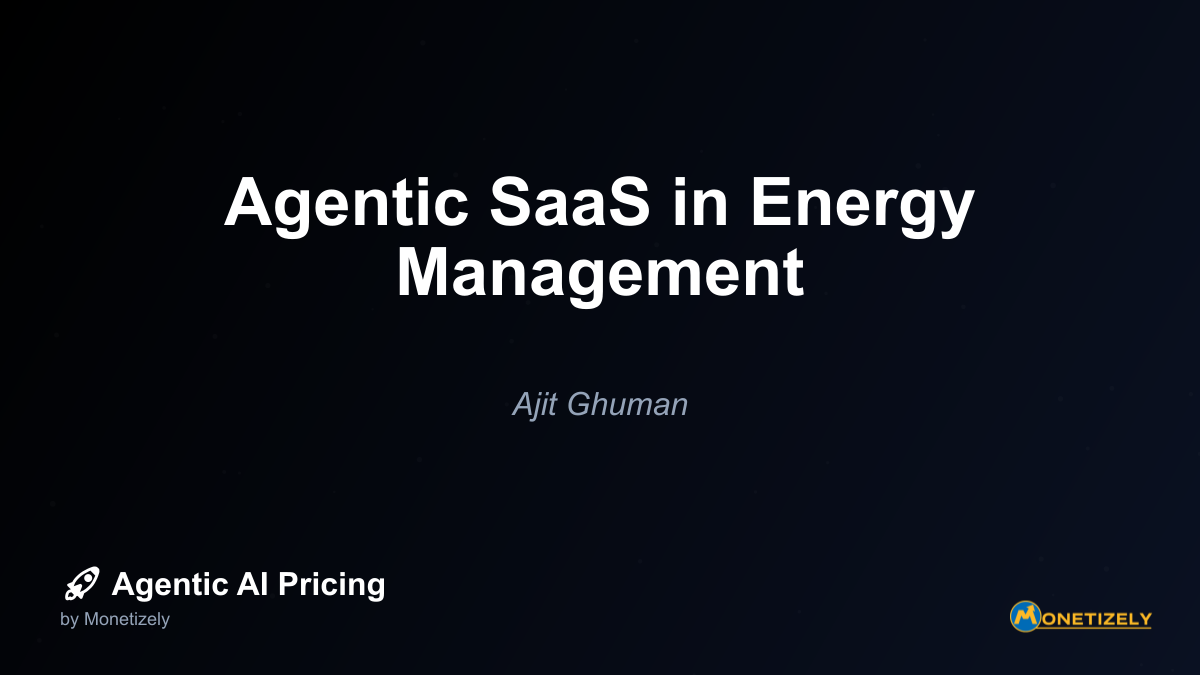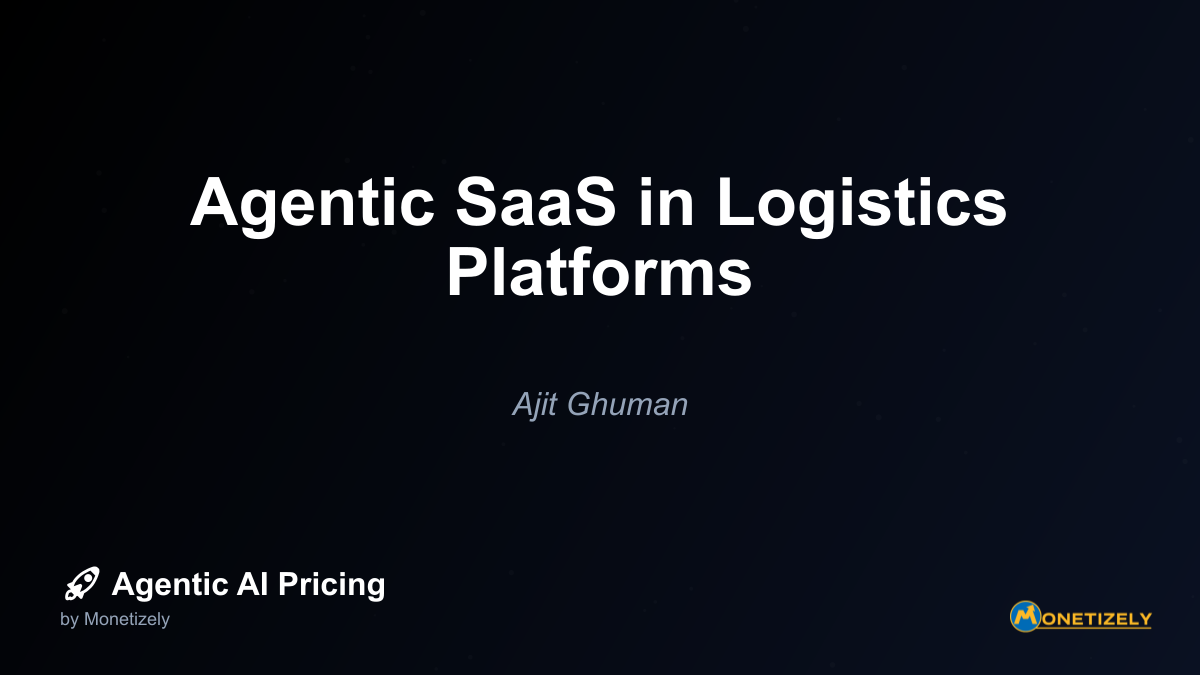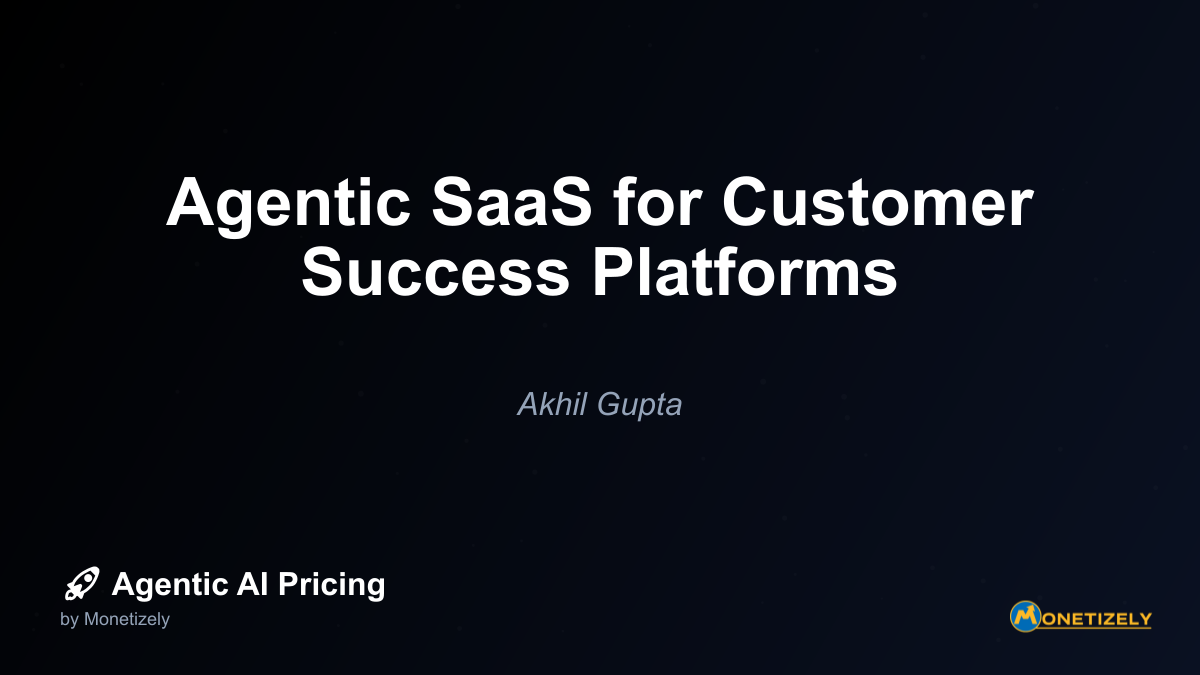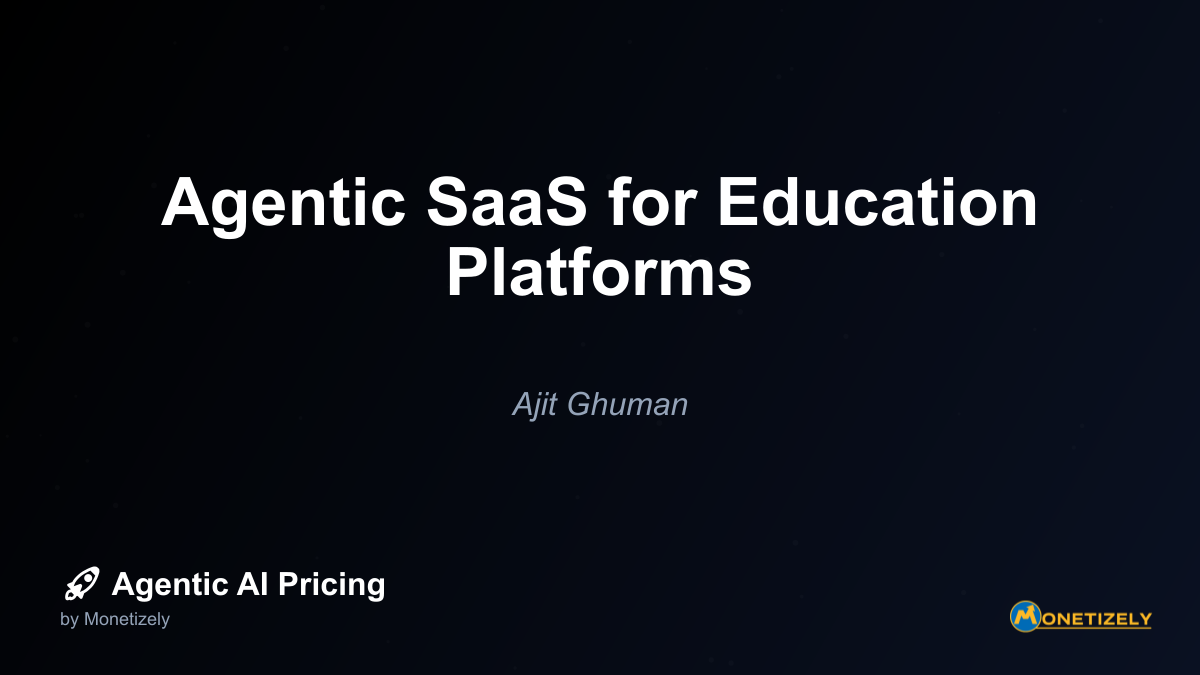· Akhil Gupta · Vertical Applications · 12 min read
Supply Chain Optimization with Agentic SaaS
AI and SaaS Pricing Masterclass
Learn the art of strategic pricing directly from industry experts. Our comprehensive course provides frameworks and methodologies for optimizing your pricing strategy in the evolving AI landscape. Earn a professional certification that can be imported directly to your LinkedIn profile.
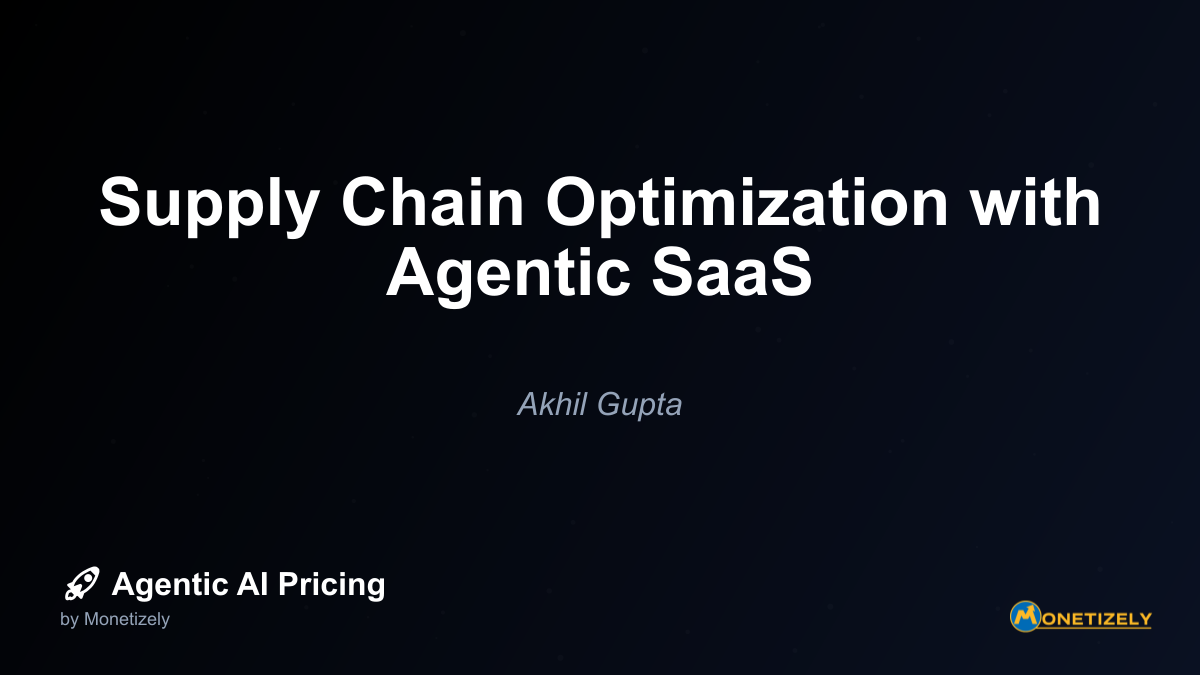
In today’s rapidly evolving business landscape, supply chain optimization has emerged as a critical competitive differentiator. The introduction of agentic artificial intelligence (AI) is fundamentally transforming how organizations approach logistics management, inventory control, and end-to-end supply chain visibility. Unlike traditional automation or basic AI implementations, agentic AI represents a paradigm shift—these systems can operate autonomously, make complex decisions, and continuously adapt to changing conditions without constant human oversight.
For senior executives and decision-makers navigating this technological revolution, understanding the strategic implications of agentic SaaS solutions in the supply chain is no longer optional—it’s imperative. This comprehensive analysis explores how agent-driven logistics SaaS is reshaping the industry, the tangible benefits it delivers, implementation challenges to anticipate, and frameworks for maximizing return on investment.
The Evolution of Supply Chain Intelligence: From Reactive to Autonomous
The journey toward intelligent supply chains has progressed through several distinct phases, each building upon the capabilities of its predecessor while addressing limitations.
Traditional Supply Chain Management Systems
Conventional supply chain management systems relied heavily on historical data, manual inputs, and rule-based decision-making. These systems excelled at handling predictable, stable environments but struggled with:
- Limited ability to respond to unexpected disruptions
- Siloed information across different supply chain functions
- Delayed decision-making due to human bottlenecks
- Inability to optimize across multiple competing variables simultaneously
The Rise of Predictive Analytics
The integration of predictive analytics represented the first significant leap forward. These systems could:
- Forecast demand patterns with greater accuracy
- Identify potential bottlenecks before they occurred
- Suggest inventory adjustments based on historical patterns
- Provide early warning signals for potential disruptions
While powerful, predictive analytics still required human interpretation and action. The insights generated were valuable, but the execution remained manual.
Agentic AI: The New Supply Chain Intelligence Paradigm
Agentic AI represents a fundamental shift in how supply chains operate. Rather than simply providing insights for human decision-makers, these systems can:
- Autonomously monitor conditions across the entire supply network
- Make independent decisions within defined parameters
- Execute multi-step processes without human intervention
- Continuously learn and adapt strategies based on outcomes
- Communicate and coordinate with other AI agents to optimize the entire system
As one supply chain executive from a Fortune 500 retailer noted, “The difference is profound. We’ve moved from systems that tell us what might happen to systems that actually respond to what is happening—often before we even realize there’s an issue.”
Market Trends and Adoption Rates: The Agentic AI Revolution in Numbers
The adoption of agentic AI in supply chain management is accelerating rapidly, driven by compelling business outcomes and competitive pressures.
Current Market Size and Growth Projections
According to recent market analysis, the agentic AI in supply chain and logistics market is expected to reach USD 8.67 billion by 2025, growing at a compound annual growth rate (CAGR) of 14.20%. This growth reflects the increasing recognition of agentic AI’s transformative potential.
Industry adoption is particularly strong in sectors where supply chain efficiency directly impacts customer satisfaction and operational costs:
- Food and Beverage: 15.6% CAGR
- Retail and E-commerce: 14.8% CAGR
- Manufacturing: 13.9% CAGR
- Healthcare and Pharmaceuticals: 12.5% CAGR
Executive Adoption Indicators
The shift toward agentic supply chain solutions is evident in executive priorities and investment decisions:
- 51% of supply chain executives have already initiated pilot programs involving autonomous agents
- 68% believe AI will be critical to future operations
- 73% plan to increase investment in agentic AI solutions over the next 24 months
As the Chief Supply Chain Officer at a leading consumer goods company observed, “We’re no longer asking if we should implement agentic AI, but rather how quickly we can scale it across our entire network.”
Core Capabilities of Agentic SaaS in Supply Chain Management
Agentic SaaS solutions in supply chain management deliver a range of capabilities that extend far beyond traditional systems. These capabilities transform how organizations plan, execute, and optimize their supply chain operations.
Autonomous Decision-Making
At the core of agentic AI is the ability to make decisions independently. Unlike traditional systems that flag exceptions for human review, agentic systems can:
- Evaluate multiple potential solutions against complex criteria
- Select optimal responses based on current conditions
- Execute decisions directly through integrated systems
- Learn from outcomes to improve future decision quality
For example, when a supplier notifies about a potential delay, an agentic system can automatically:
- Evaluate the impact on production schedules
- Identify alternative suppliers or routes
- Adjust production plans to minimize disruption
- Communicate changes to affected stakeholders
- Document the decision process for future reference
Dynamic Inventory Optimization
Inventory management represents one of the most impactful applications of agentic AI, balancing the competing objectives of minimizing carrying costs while ensuring product availability.
Agentic inventory systems can:
- Continuously recalculate optimal inventory levels based on real-time demand signals
- Autonomously adjust reorder points and quantities across thousands of SKUs
- Proactively redistribute inventory between locations to maximize availability
- Identify slow-moving items and recommend markdown strategies
- Coordinate with procurement agents to optimize supplier orders
The results are compelling: companies implementing agentic inventory management report:
- 20-30% improvement in inventory accuracy
- Up to 50% fewer stockouts
- 15-25% reduction in excess inventory
Intelligent Supplier Management
Agentic AI transforms supplier relationships by enabling more responsive, data-driven interactions:
- Continuous evaluation of supplier performance against KPIs
- Automatic identification of quality or delivery issues
- Dynamic adjustment of order quantities based on performance
- Proactive communication with suppliers about changing requirements
- Autonomous negotiation of pricing and terms within defined parameters
Predictive Maintenance and Asset Optimization
For organizations with significant logistics assets (trucks, warehouses, distribution centers), agentic AI enables:
- Predictive maintenance scheduling based on actual usage and condition
- Dynamic routing of assets to maximize utilization
- Autonomous adjustment of maintenance schedules based on operational demands
- Continuous optimization of asset deployment across the network
End-to-End Supply Chain Visibility
Perhaps most importantly, agentic systems provide unprecedented visibility across the entire supply chain:
- Real-time tracking of all materials, components, and finished goods
- Automatic identification of potential bottlenecks or disruptions
- Dynamic recalculation of delivery timeframes
- Proactive notification of affected stakeholders
- Continuous optimization of the entire supply network
Real-World Implementation: Case Studies in Agentic Supply Chain Success
The theoretical benefits of agentic supply chain solutions are compelling, but real-world implementations provide the most persuasive evidence of their value. The following case studies illustrate how leading organizations are leveraging agentic AI to transform their supply chain operations.
Amazon: Autonomous Demand Forecasting and Inventory Management
Challenge: Amazon faced the immense complexity of forecasting demand and optimizing inventory across over 400 million SKUs, with seasonal variations, promotional impacts, and rapidly changing consumer preferences.
Agentic AI Solution: Amazon implemented an autonomous demand forecasting system that analyzes customer data, market trends, and external factors to optimize stock levels and automate reordering with minimal human input.
Results:
- 35% reduction in excess inventory
- 25% improvement in inventory turnover
- 15% reduction in storage costs
- Enhanced ability to respond to unexpected demand surges
Lessons Learned: The scale and complexity of Amazon’s implementation required massive data integration. Continuous learning was essential to maintain accuracy, particularly for new product introductions.
Siemens: Predictive Maintenance and Production Scheduling
Challenge: Unplanned machinery failures caused significant downtime and disrupted production schedules, creating cascading effects throughout the supply chain.
Agentic AI Solution: Siemens deployed predictive maintenance AI agents that forecast equipment failures by analyzing sensor and operational data, enabling proactive intervention before failures occur.
Results:
- 30% reduction in unplanned downtime
- 20% decrease in maintenance costs
- More reliable production scheduling
- Improved on-time delivery performance
Lessons Learned: Integration with legacy equipment sensor data presented significant challenges. The system required robust real-time data feeds to maintain prediction accuracy.
Walmart: Autonomous Store-Floor Inventory Management
Challenge: Walmart struggled with overstocking, stockouts, and inefficient manual inventory audits across its vast network of retail locations.
Agentic AI Solution: Autonomous store-floor AI bots monitor shelf inventory, trigger restocking, and optimize product placement based on real-time sales data and foot traffic patterns.
Results:
- 35% reduction in excess inventory
- 15% improvement in inventory accuracy
- Reduced labor costs for inventory management
- Enhanced customer experience through better product availability
Lessons Learned: Physical robot deployment in retail spaces required ongoing maintenance. Staff initially resisted automation but became advocates as they were freed from repetitive tasks to focus on customer service.
European Logistics Provider: Dynamic Route Optimization
Challenge: A major European logistics provider faced frequent delivery delays and high fuel consumption due to inefficient route planning that couldn’t adapt to real-time conditions.
Agentic AI Solution: Implemented an agentic system that manages the delivery network using real-time GPS, weather, and congestion data to optimize routes autonomously.
Results:
- 30% fewer delivery delays
- 12% reduction in fuel usage
- 18% increase in driver productivity
- Enhanced customer satisfaction through more reliable delivery windows
Lessons Learned: The system required extensive integration of diverse live data sources. Managing exception cases like sudden road closures presented ongoing challenges that required continuous refinement of the AI’s decision-making parameters.
Blue Yonder: Comprehensive Supply Chain Orchestration
Challenge: Achieving alignment across supply-demand planning, shelf management, logistics, warehouse operations, and network monitoring simultaneously.
Agentic AI Solution: Deployed a suite of coordinated AI agents handling inventory diagnosis, automatic planogram editing, logistics rerouting, dynamic warehouse worker allocation, and risk monitoring, with agents automating confirmations and prioritizing containers to maintain on-time delivery.
Results:
- 40% reduction in supply chain disruption impacts
- 25% improvement in warehouse productivity
- 18% enhancement in on-time delivery performance
- More resilient overall supply chain operations
Lessons Learned: Coordinating multiple agents required sophisticated orchestration. Continuous monitoring was essential to avoid cascade failures under uncertain conditions.
Key Implementation Challenges and Mitigation Strategies
While the potential benefits of agentic supply chain solutions are substantial, implementation presents significant challenges that must be addressed systematically.
Integration with Legacy Systems
Challenge: Most organizations operate complex ecosystems of legacy systems that weren’t designed for integration with autonomous AI agents.
Mitigation Strategies:
- Implement middleware layers that translate between legacy systems and AI agents
- Prioritize API development for critical systems
- Consider phased implementation that targets high-value processes first
- Develop clear data standardization protocols
- Establish robust testing procedures to verify system interactions
Data Quality and Availability
Challenge: Agentic AI systems require high-quality, real-time data from multiple sources to function effectively.
Mitigation Strategies:
- Conduct comprehensive data audits to identify gaps and quality issues
- Implement data governance frameworks to ensure ongoing data quality
- Deploy edge computing solutions to capture real-time operational data
- Develop data cleaning and normalization processes
- Create fallback mechanisms for situations where data is unavailable or unreliable
Change Management and Organizational Resistance
Challenge: Implementing agentic AI fundamentally changes how people work, often leading to resistance and adoption challenges.
Mitigation Strategies:
- Develop clear communication plans that explain the benefits and address concerns
- Involve key stakeholders in the design and implementation process
- Provide comprehensive training that emphasizes new roles and responsibilities
- Create centers of excellence to support adoption and share best practices
- Implement phased rollouts that allow for adjustment and learning
Ethical and Governance Considerations
Challenge: Autonomous systems raise important questions about accountability, transparency, and control.
Mitigation Strategies:
- Develop clear governance frameworks that define decision boundaries for AI agents
- Implement comprehensive audit trails for all autonomous decisions
- Establish human oversight mechanisms for high-impact decisions
- Create ethical guidelines for AI development and deployment
- Regularly review and refine governance processes as capabilities evolve
Technical Infrastructure Requirements
Challenge: Agentic AI systems require robust technical infrastructure to support real-time processing, large-scale data management, and secure operations.
Mitigation Strategies:
- Assess current infrastructure capabilities against requirements
- Consider cloud-based solutions to enhance scalability and flexibility
- Implement robust security protocols to protect sensitive data
- Develop disaster recovery and business continuity plans
- Establish monitoring systems to identify and address performance issues
Technical Considerations and Infrastructure Requirements
Implementing agentic AI in supply chain operations requires careful attention to technical considerations and infrastructure requirements. Organizations must ensure they have the necessary foundation to support these advanced systems.
Technology Stack Components
A comprehensive agentic AI implementation typically includes:
Large Language Models (LLMs): Provide natural language processing capabilities for human-AI interaction and unstructured data analysis.
IoT Sensors and Edge Computing: Capture real-time operational data from physical assets and environments.
Digital Twins: Create virtual representations of physical supply chain components for simulation and optimization.
ERP and WMS Integration: Connect with core business systems to access transactional data and execute decisions.
Cloud Infrastructure: Provides scalable computing resources for data processing and AI workloads.
Data Lakes and Warehouses: Store and organize the massive datasets required for AI training and operation.
API Gateways: Facilitate secure communication between different systems and components.
Visualization and Monitoring Tools: Enable human oversight and intervention when necessary.
Network Infrastructure Requirements
Reliable network connectivity is essential for agentic AI systems, particularly when coordinating actions across geographically distributed operations. Key considerations include:
- Bandwidth: Sufficient capacity to handle large volumes of real-time data
- Latency: Minimal delay for time-sensitive operations
- Reliability: Redundant connections to prevent disruptions
- Security: Robust protection against unauthorized access or data breaches
- Edge Computing: Local processing capabilities for situations where connectivity is limited
Data Management Considerations
Effective data management is critical for agentic AI success:
- Data Governance: Clear policies for data quality, access, and usage
- Master Data Management: Consistent definitions and hierarchies across systems
- Real-time Processing: Capabilities to analyze and act on data as it’s generated
- Data Security: Comprehensive protection for sensitive information
- Compliance: Adherence to relevant regulations and standards
Integration Approaches
Organizations typically adopt one of several integration approaches:
API-First Strategy: Developing comprehensive APIs for all systems to enable seamless integration
Middleware Deployment: Implementing integration layers that translate between different systems
Microservices Architecture: Breaking functionality into discrete, independently deployable services
Event-Driven Architecture: Using events and messages to coordinate actions across systems
Hybrid Approaches: Combining multiple strategies based on specific requirements
Pricing Strategies for Agentic Supply Chain SaaS Solutions
The pricing of agentic AI solutions for supply chain management presents unique challenges and opportunities. Traditional SaaS pricing models may not fully capture the value these systems deliver or align incentives appropriately.
Prevalent Pricing Models
Several pricing models have emerged for agentic supply chain solutions:
1. Usage-Based Pricing
This model charges based on actual resource consumption, such as:
- Number of decisions made
- Volume of data processed
- Computing resources utilized
- Tokens or credits consumed
Advantages:
- Aligns costs with actual utilization
- Scales naturally with organizational growth
- Lower barrier to entry
Disadvantages:
- Can create unpredictable costs
- May discourage full utilization
- Difficult to budget accurately
2. Agent-Based Pricing
Under this model, organizations pay for each AI agent deployed, either through:
- One-time licensing fees
- Subscription fees per agent
- Tiered pricing based on agent capabilities
Advantages:
- Simplified cost structure
- Clear relationship between capabilities and costs
- Easier budgeting and forecasting
Disadvantages:
- May not reflect actual value delivered
- Can discourage deployment of additional agents
- Potential for underutilization
3. Value-Based Pricing
This approach ties costs directly to the value delivered, measured through:
- Cost savings achieved
- Revenue increases generated
- Performance improvements
- Specific business outcomes
Advantages:
- Direct alignment with business value
- Shared risk between vendor and customer
- Incentivizes ongoing optimization
Disadvantages:
- Requires sophisticated measurement capabilities
- More complex to implement and administer
- May involve challenging negotiations
4. Delivery Success Pricing
Specifically for logistics applications, this model weights pricing based on:
- Economic value of specific deliveries
- Customer lifetime value considerations
- Penalties avoided
- Strategic significance of deliveries
Advantages:
- Prioritizes high-value outcomes
- Enhances customer retention
- Aligns pricing with business impact
Disadvantages:
- Complex to implement and communicate
- Requires sophisticated value assessment
- May create unexpected cost variations
Emerging Hybrid Models
Increasingly, vendors are developing hybrid pricing approaches that combine elements of multiple models:
- Core + Consumption: Fixed fee for basic capabilities with usage-based charges for advanced features
- **Tiered Value-
Co-Founder & COO
Akhil is an Engineering leader with over 16+ years of experience in building, managing and scaling web-scale, high throughput enterprise applications and teams. He has worked with and led technology teams at FabAlley, BuildSupply and Healthians. He is a graduate from Delhi College of Engineering and UC Berkeley certified CTO.
Pricing Strategy Audit
Let our experts analyze your current pricing strategy and identify opportunities for improvement. Our data-driven assessment will help you unlock untapped revenue potential and optimize your AI pricing approach.

